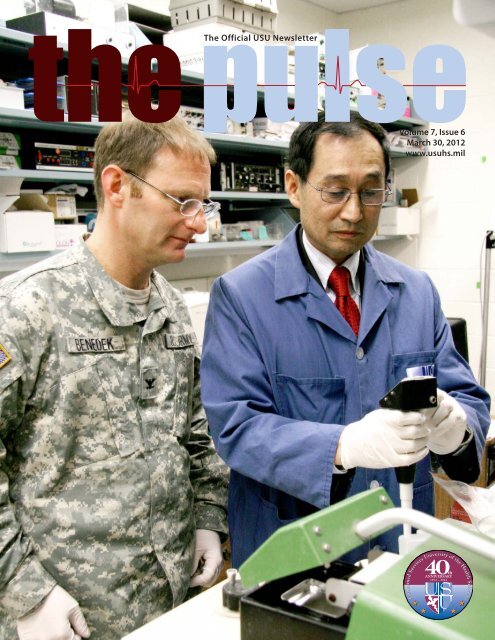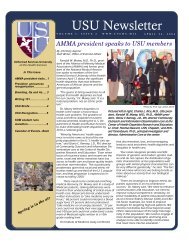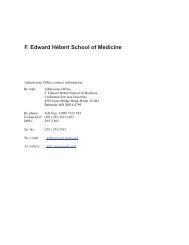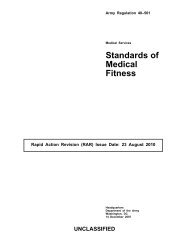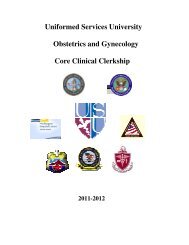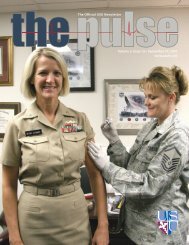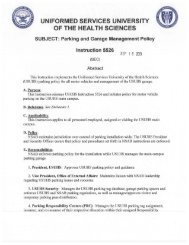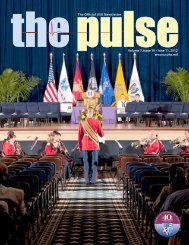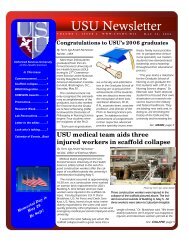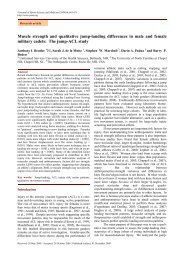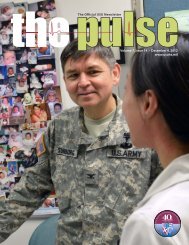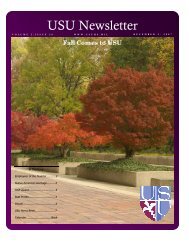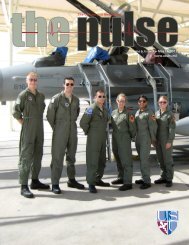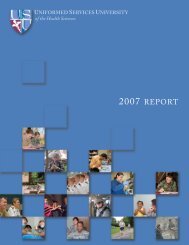Understanding PTSD - Uniformed Services University of the Health ...
Understanding PTSD - Uniformed Services University of the Health ...
Understanding PTSD - Uniformed Services University of the Health ...
Create successful ePaper yourself
Turn your PDF publications into a flip-book with our unique Google optimized e-Paper software.
The Official USU Newsletter<br />
Volume 7, Issue 6<br />
March 30, 2012<br />
www.usuhs.mil
Sharon Willis<br />
Deputy Vice President for External<br />
Affairs and Managing Editor<br />
Christine Creenan-Jones<br />
Contributing Writer<br />
Lori Fields<br />
Layout and Design<br />
Production<br />
Editorial content is edited, prepared<br />
and provided by <strong>the</strong> USU Office <strong>of</strong><br />
External Affairs unless o<strong>the</strong>rwise<br />
indicated. The Pulse staff may<br />
include or exclude articles based<br />
upon news value, impact on <strong>the</strong><br />
university and space availability.<br />
Submissions<br />
The Pulse will be published<br />
bi-weekly on Mondays. The<br />
deadline for submissions is at 4 p.m.<br />
Tuesday prior to <strong>the</strong> publication<br />
date. Submissions can be sent to<br />
swillis@usuhs.mil or by calling<br />
301-295-3578.<br />
Photo by Sharon Willis<br />
On <strong>the</strong> cover<br />
Army Col. (Dr.) David Benedek and Dr. Lei<br />
Zhang, from USU’s Center for <strong>the</strong> Study <strong>of</strong><br />
Traumatic Stress, are conducting a research<br />
study to identify potential biomarkers for<br />
<strong>PTSD</strong>. (See story, page 6.)<br />
2 The Pulse The Official USU Newsletter<br />
Esteemed surgeon delivers<br />
27th Annual Packard Lecture<br />
By Christine Creenan-Jones<br />
(Pictured, left to right) Dr. Jeffrey Longacre, interim VP for External Affairs, USU; Dr.<br />
Murray Brennan, 27th Annual David Packard Lecturer; Col. (Dr.) Craig Shriver, director,<br />
Comprehensive Cancer Center; and Dr. Tonie Hooper, president, USU Faculty Senate.<br />
Renowned surgeon and researcher,<br />
Murray F. Brennan, M.D., F.A.C.S., was<br />
<strong>the</strong> guest speaker for <strong>the</strong> 2012 David<br />
Packard Lecture, sponsored by <strong>the</strong> USU<br />
Faculty Senate, with support from <strong>the</strong><br />
Henry M. Jackson Foundation for <strong>the</strong><br />
Advancement <strong>of</strong> Military Medicine, on<br />
March 15. His presentation,”Lessons<br />
Learned as a Surgical Oncologist,” drew<br />
inspiration from his bench and bedside<br />
experiences at places like Harvard<br />
Medical School, <strong>the</strong> National Institutes<br />
<strong>of</strong> <strong>Health</strong> and Memorial Sloan-Kettering<br />
Cancer Center, where he currently<br />
serves as <strong>the</strong> Benno C. Schmidt Chair<br />
in Clinical Oncology, Director <strong>of</strong> <strong>the</strong><br />
International Center and Vice President<br />
for International Programs.<br />
While speaking at USU, Brennan<br />
also emphasized <strong>the</strong> importance <strong>of</strong><br />
mentorship in medical pr<strong>of</strong>essions, <strong>the</strong><br />
evolution <strong>of</strong> cancer care and <strong>the</strong> need<br />
for objective approaches when treating<br />
vexing diseases like cancer.<br />
“We are prisoners <strong>of</strong> our own<br />
biases,” said Brennan, who believes<br />
today’s physicians are too narrowly<br />
focused on finding data to support<br />
<strong>the</strong>ir personal objectives. Instead,<br />
providers should weigh <strong>the</strong> benefits<br />
and consequences <strong>of</strong> treatment, use<br />
critical eyes when evaluating research<br />
and find better ways to educate<br />
patients, he continued.<br />
Brennan’s words—validated by<br />
decades <strong>of</strong> groundbreaking work—<br />
resonated with <strong>the</strong> crowd, including<br />
Army Colonel (Dr.) Craig Shriver,<br />
director <strong>of</strong> <strong>the</strong> Comprehensive Cancer<br />
Center, who provided opening remarks<br />
for this year’s Packard Lecture.<br />
“It’s not hyperbole to state that Dr.<br />
Murray Brennan is a pioneer and<br />
living legend,” Shriver said. “It’s fitting<br />
that we honor him at USU on its 40th<br />
anniversary, because his influence<br />
on military surgery has been nearly<br />
unprecedented amongst surgeons <strong>of</strong><br />
<strong>the</strong> modern era.”<br />
Dr. Brennan has trained several<br />
military physicians throughout his<br />
illustrious career, including four<br />
program directors and several combat<br />
doctors. His exceptional career and<br />
unique expertise were major reasons<br />
why Brennan was invited to speak<br />
during <strong>the</strong> Packard Lecture, one <strong>of</strong><br />
USU’s most prestigious academic<br />
events, named after <strong>the</strong> university’s<br />
second president, former Deputy<br />
Secretary <strong>of</strong> Defense and co-founder <strong>of</strong><br />
<strong>the</strong> Hewlett-Packard Company.<br />
Courtesy Photo
<strong>Understanding</strong> <strong>PTSD</strong><br />
By Christine Creenan-Jones<br />
Diagnosing posttraumatic stress<br />
disorder is difficult. Servicemembers<br />
don’t always report <strong>the</strong>ir symptoms or<br />
make <strong>the</strong> proper connections between<br />
emotional trauma and <strong>the</strong> body’s<br />
response to extreme stress, especially<br />
since negative physical reactions <strong>of</strong>ten<br />
times occur weeks, months or even<br />
years later.<br />
In <strong>the</strong>se unreported cases, clinicians<br />
have little recourse, because<br />
<strong>the</strong>re are no effective laboratory tests<br />
for identifying <strong>PTSD</strong>. But, Army<br />
Colonel David Benedek, M.D., and<br />
Lei Zhang, M.D., researchers at USU’s<br />
Center for <strong>the</strong> Study <strong>of</strong> Traumatic<br />
Stress, are working to improve screening<br />
standards by identifying potential<br />
biomarkers for <strong>PTSD</strong> in <strong>the</strong><br />
Traumatic Stress and Biomarkers in a<br />
Military Population Study.<br />
Their research is already yielding<br />
promising results. Benedek, Zhang and<br />
<strong>the</strong>ir CSTS co-investigators found a<br />
measurable difference in p11 mRNA<br />
protein levels between soldiers reporting<br />
<strong>PTSD</strong> symptoms and blood samples<br />
from patients with o<strong>the</strong>r disorders– a<br />
distinction that could lead to a major<br />
breakthrough in diagnostic assessment.<br />
“If biomarkers are identified,<br />
physicians will be able to definitively<br />
diagnose <strong>PTSD</strong> through blood and<br />
saliva samples, instead <strong>of</strong> using more<br />
ambiguous symptom checklists and<br />
patient self-reports,” he said. “Fur<strong>the</strong>rmore,<br />
biomarkers will help us detect<br />
<strong>the</strong> <strong>PTSD</strong> earlier so treatment can<br />
Photo by Sharon Willis<br />
USU to host Dining Out<br />
The <strong>Uniformed</strong> <strong>Services</strong> <strong>University</strong><br />
<strong>of</strong> <strong>the</strong> <strong>Health</strong> Sciences Dining<br />
Out will be held on Saturday, April<br />
14, 2012, from 6:00-11:00 p.m., in<br />
<strong>the</strong> USU dining room. This year<br />
<strong>the</strong> featured guest speaker is Air<br />
Force Maj. Gen. Kimberly Siniscalchi,<br />
<strong>the</strong> Assistant Force Surgeon<br />
General, Medical Force Development<br />
and Assistant Surgeon<br />
General, Nursing <strong>Services</strong>.<br />
Ticket prices will be: E1-E9: $55;<br />
O1-O3: $75; O4+: $80. Tickets for<br />
guests are <strong>the</strong> same price as <strong>the</strong>ir<br />
military sponsor. Tickets for civilian<br />
attendees not accompanied by a<br />
military sponsor are <strong>the</strong> same as <strong>the</strong><br />
04+ price listed. Tickets will be sold<br />
each day in <strong>the</strong> lobby <strong>of</strong> Building B<br />
from 11:30 a.m. -1:00 p.m.<br />
begin sooner and troops may begin to<br />
heal faster.”<br />
Improved diagnostics and <strong>the</strong>rapies<br />
for <strong>PTSD</strong> is one <strong>of</strong> military medicine’s<br />
biggest, most pressing goals right<br />
now. The debilitating anxiety disorder<br />
affects thousands <strong>of</strong> people each year,<br />
and susceptibility increases for people<br />
with combat experience–exactly <strong>the</strong><br />
population Benedek is evaluating at<br />
Ft. Bragg, a major deployment hub in<br />
North Carolina.<br />
“Military members willingly go into<br />
harm’s way to protect our country, so it’s<br />
our job as uniformed medical pr<strong>of</strong>essional<br />
to find better, more innovative<br />
ways to help <strong>the</strong>m feel better when <strong>the</strong>y<br />
return home emotionally or physically<br />
injured,” he said.<br />
Part <strong>of</strong> this effort includes identifying<br />
biomarkers for resilience. Trauma<br />
effects people differently, even servicemembers<br />
in <strong>the</strong> same platoon who<br />
share similar frontline experiences.<br />
“Some people develop <strong>PTSD</strong>, o<strong>the</strong>rs<br />
don’t. <strong>Understanding</strong> both sides <strong>of</strong><br />
<strong>the</strong> paradox is an important part <strong>of</strong><br />
our research,” Benedek said. “If we<br />
know what keeps some people healthy,<br />
perhaps <strong>the</strong>n, we can prevent <strong>the</strong> <strong>PTSD</strong><br />
from occurring in <strong>the</strong> first place.”<br />
March 30, 2012 3
David Scott, <strong>the</strong> groundbreaker next door<br />
By Christine Creenan-Jones<br />
David Scott, PhD, vice chair for<br />
research in <strong>the</strong> USU Department <strong>of</strong><br />
Medicine, has been shaping science<br />
in <strong>the</strong> world’s best laboratories for<br />
decades now. His work – immune<br />
tolerance research – has led to many<br />
breakthroughs, especially for autoimmune<br />
diseases, conditions where <strong>the</strong><br />
body destroys normal tissue because it<br />
can’t distinguish between helpful and<br />
harmful cells.<br />
Scott is continuing this important<br />
work at USU, and he’s crossing boundaries,<br />
too. The New Jersey native, an<br />
immunologist by training, is collaborating<br />
with <strong>the</strong> nation’s leading gene <strong>the</strong>rapists.<br />
Toge<strong>the</strong>r, <strong>the</strong>y’re finding ways<br />
4 The Pulse The Official USU Newsletter<br />
to “reeducate” <strong>the</strong> immune system, so<br />
helpful proteins aren’t damaged by <strong>the</strong><br />
body’s natural defenses.<br />
“<strong>Understanding</strong> how <strong>the</strong> body<br />
turns responses on and <strong>of</strong>f is helpful<br />
for many different reasons, including<br />
<strong>the</strong> potential for researchers<br />
to develop life-saving vaccines for<br />
autoimmune diseases, which affect<br />
millions <strong>of</strong> people around <strong>the</strong> world<br />
each year,” he said.<br />
Scott is growing o<strong>the</strong>r groundbreaking<br />
research at USU, too. He teaches<br />
effective grant-writing skills – an<br />
important, but daunting part <strong>of</strong> <strong>the</strong><br />
research process. Scott also mentors<br />
faculty members at <strong>the</strong> university and<br />
Photo by Thomas C. Balfour<br />
Photo by Thomas C. Balfour<br />
encourages multidisciplinary partnerships,<br />
both on campus and at nearby<br />
research laboratories.<br />
“I’ve really enjoyed being part <strong>of</strong><br />
USU’s faculty, <strong>the</strong>y’re truly an incredible<br />
group,” he said. “Developing new<br />
methods for expanding <strong>the</strong> university’s<br />
already strong research programs<br />
is exciting, too. Good investigators<br />
make great instructors, and military<br />
medicine needs both.”<br />
For Scott, his 2010 faculty appointment<br />
at USU was both a homecoming<br />
and a calling. The Be<strong>the</strong>sda doctor<br />
used to travel more than 40 miles<br />
every day to his job at <strong>the</strong> <strong>University</strong><br />
<strong>of</strong> Maryland, where he worked as <strong>the</strong><br />
associate director <strong>of</strong> <strong>the</strong> Center for<br />
Vascular and Inflammatory Diseases.<br />
“Working in Baltimore was great,<br />
but I wanted to be closer to my home,<br />
and I really respected <strong>the</strong> powerful<br />
mission at USU,” he said. “I felt like I<br />
was part <strong>of</strong> something honorable and<br />
much bigger than my research alone<br />
when I came here.”<br />
An important part <strong>of</strong> <strong>the</strong> university<br />
thread now, Scott bicycles to work<br />
most mornings, ano<strong>the</strong>r one <strong>of</strong> his<br />
passions. The 15-minute ride gives<br />
Scott enough time to clear his head<br />
before ano<strong>the</strong>r busy day <strong>of</strong> groundbreaking<br />
science begins.<br />
Ultrasound Training<br />
Navy Reserve Lt. (Dr.) Tress Goodwin<br />
(far right) teaches bedside renal<br />
ultrasound to <strong>the</strong> first-year USU<br />
medical student class. Hands-on<br />
ultrasound training complements and<br />
reinforces <strong>the</strong> teaching <strong>of</strong> anatomy,<br />
physiology, pathology, and medical<br />
decision-making, and it provides a<br />
natural bridge between basic science<br />
education and <strong>the</strong> clinical practice <strong>of</strong><br />
medicine. Bedside ultrasound training<br />
has been integrated into all <strong>of</strong> <strong>the</strong><br />
pre-clerkship modules in <strong>the</strong> new USU<br />
medical student curriculum.
USU License Plate Available to<br />
Maryland Residents<br />
By Sharon Willis<br />
If you’ve ever been behind a car<br />
with organizational license plates and<br />
thought, ‘I wish USU had those,’ your<br />
wish has been granted.<br />
USU students, staff, faculty and<br />
alumni who are residents <strong>of</strong> <strong>the</strong> State<br />
<strong>of</strong> Maryland are eligible to apply for<br />
a <strong>Uniformed</strong> <strong>Services</strong> <strong>University</strong> <strong>of</strong><br />
<strong>the</strong> <strong>Health</strong> Sciences organizational<br />
license plate.<br />
The license plate was actually developed<br />
several years ago and a look<br />
around <strong>the</strong> USU parking garage will<br />
show a number <strong>of</strong> cars already sporting<br />
one, including President Charles Rice’s<br />
personal vehicle.<br />
“This year marks our 40th Anniversary.<br />
We have accomplished so much<br />
over <strong>the</strong> past four decades for which<br />
we can be extraordinarily proud,” said<br />
Rice. “I can’t think <strong>of</strong> a simpler way to<br />
show your pride and support for <strong>the</strong><br />
university every day than through USU<br />
organizational license plates.”<br />
The Motor Vehicle Administration<br />
(MVA) fee for <strong>the</strong> USU license plate<br />
is $25 per vehicle. They are available<br />
for passenger cars, motorcycles,<br />
multi-purpose vehicles, and trucks<br />
with a one-ton or less manufacturer’s<br />
rate capacity.<br />
The organizational plates are only<br />
available for Maryland residents.<br />
Unfortunately, <strong>the</strong> District <strong>of</strong> Columbia<br />
does not <strong>of</strong>fer organizational plates<br />
and <strong>the</strong> State <strong>of</strong> Virginia requires a<br />
minimum <strong>of</strong> 350 confirmed interested<br />
residents before it will establish an<br />
organizational plate.<br />
Anyone interested in applying for<br />
<strong>the</strong> plate, which shows <strong>the</strong> university<br />
logo and <strong>the</strong> letters ‘U-S-U‘ followed<br />
by <strong>the</strong> MVA-assigned sequential tag<br />
number, must pick up <strong>the</strong> Application/Certification<br />
for Organizational<br />
License Plates from <strong>the</strong> Office <strong>of</strong><br />
External Affairs, Room A1025. The<br />
form must be signed by Ms. Sandra<br />
Carbajal, <strong>the</strong> USU coordinator for<br />
<strong>the</strong> organizational plate, and must<br />
include <strong>the</strong> vehicle’s title number on<br />
it. Once Ms. Carbajal has signed <strong>the</strong><br />
application form, interested employees<br />
can apply for <strong>the</strong> plates in person<br />
at any <strong>of</strong> <strong>the</strong> MVA’s full service branch<br />
<strong>of</strong>fices (http://www.mva.maryland.<br />
gov/hours-Locations/default.asp).<br />
The request will <strong>the</strong>n be forwarded<br />
to <strong>the</strong> Glen Burnie MVA <strong>of</strong>fice for<br />
processing. Applications may also<br />
be mailed to <strong>the</strong> MVA’s Specialty Tag<br />
Unit in <strong>the</strong> Glen Burnie <strong>of</strong>fice: MVA<br />
Specialized Tag Unit, 6601 Ritchie<br />
Highway, Glen Burnie, MD 21062, or<br />
taken to an MVA licensed tag and title<br />
service (http://www.mva.maryland.<br />
gov/Vehicle-<strong>Services</strong>/REG/titleagents.<br />
htm), for assistance with applying.<br />
Organizational plates cannot be<br />
ordered online.<br />
USU Research Days 2012<br />
May 14-15<br />
Save The Date<br />
Visit www.hjf.org to<br />
One Year Later A Look<br />
Back at <strong>the</strong> Aftermath<br />
<strong>of</strong> <strong>the</strong> Tohoku<br />
Earthquake, Tsunami<br />
By Helen Hocknell,<br />
NSA Be<strong>the</strong>sda Journal staff writer<br />
Air Force Capt. Brian Livingston<br />
and Navy Lt.jg. Lee Alleman<br />
spend a lot <strong>of</strong> time preparing for<br />
situations <strong>the</strong>y hope will never<br />
happen. Livingston and Alleman<br />
are health physicists assigned to<br />
<strong>the</strong> Medical Military Operations<br />
(MMO) department <strong>of</strong> <strong>the</strong> Armed<br />
Forces Radiobiology Research<br />
Institute (AFRRI).<br />
On March 11, 2011, a 9.0 magnitude<br />
earthquake <strong>of</strong>f <strong>the</strong> eastern coast<br />
<strong>of</strong> Japan caused <strong>the</strong> primary power<br />
source for <strong>the</strong> nuclear reactors at <strong>the</strong><br />
Fukushima Daiichi power plant to<br />
shut down. Minutes later, a 20-foot<br />
tsunami took out <strong>the</strong> backup generators.<br />
The resulting cooling system<br />
failure, explained Livingston, meant<br />
<strong>the</strong> beginning <strong>of</strong> <strong>the</strong> largest nuclear<br />
disaster since Chernobyl.<br />
During <strong>the</strong> aftermath, units from<br />
all branches <strong>of</strong> <strong>the</strong> U.S. military<br />
responded to <strong>the</strong> crisis, providing<br />
humanitarian aid, scientific expertise,<br />
and military assistance.<br />
Livingston and Alleman<br />
deployed to Japan with <strong>the</strong> Medical<br />
Radiobiology Advisory Team<br />
(MRAT) following <strong>the</strong> Tohoku<br />
earthquake and tsunami. The two<br />
were part <strong>of</strong> a team helping U.S.<br />
troops deal with <strong>the</strong> aftereffects<br />
<strong>of</strong> <strong>the</strong> Fukushima Daiichi nuclear<br />
plant incident. They assisted<br />
<strong>the</strong> Consequence Management<br />
Advisory Team (CMAT) <strong>of</strong> <strong>the</strong><br />
Defense Threat Reduction Agency<br />
(DTRA), which also provides<br />
security oversight to prepare for <strong>the</strong><br />
possibility <strong>of</strong> chemical or biological<br />
attacks at major events like<br />
presidential inaugurations and <strong>the</strong><br />
Super Bowl.<br />
submit abstracts by March 23 and register for events. Continued to page 6<br />
March 30, 2012 5
Tohoku Earthquake<br />
Continued from page 5<br />
“It was pretty much panic for <strong>the</strong><br />
first two weeks,” said Livingston. “The<br />
barrier between <strong>the</strong> reactor and <strong>the</strong><br />
environment was completely compromised,<br />
so we had to assume that a<br />
complete meltdown was a possibility.”<br />
Alleman said <strong>the</strong>ir main focus was<br />
to make sure <strong>the</strong> U.S. troops providing<br />
humanitarian assistance to <strong>the</strong><br />
Japanese civilians were kept safe, but<br />
that it was difficult working with<br />
limited information.<br />
“Initially, we weren’t sure what was<br />
coming out <strong>of</strong> <strong>the</strong> reactors, so it was<br />
unclear day to day whe<strong>the</strong>r we should<br />
expect ano<strong>the</strong>r plume to be released,”<br />
said Alleman. Because <strong>of</strong> <strong>the</strong> uncertainty,<br />
<strong>the</strong>y recommended precautions, such as<br />
taking potassium iodide to protect <strong>the</strong><br />
thyroid from <strong>the</strong> radio iodide present<br />
in <strong>the</strong> “warm zone” - <strong>the</strong> area around<br />
<strong>the</strong> reactors deemed to have potentially<br />
dangerous levels <strong>of</strong> radiation.<br />
Dr. Regina Armstrong, director <strong>of</strong><br />
USU’s Center for Neuroscience and<br />
Regenerative medicine, discusses brain<br />
function with a group <strong>of</strong> students from<br />
throughout <strong>the</strong> country who were in<br />
Baltimore, Md., recently attending <strong>the</strong><br />
American Society for Neurochemistry’s<br />
High School Science Day. The students<br />
also included <strong>the</strong> winners <strong>of</strong> <strong>the</strong> USA<br />
National Brain Bee.<br />
6 The Pulse The Official USU Newsletter<br />
Photo by Sharon Willis<br />
Although <strong>the</strong> situation was chaotic<br />
at first, Alleman said it was an exciting<br />
opportunity to put <strong>the</strong>ir expertise<br />
to good use. The main mission <strong>of</strong> <strong>the</strong><br />
MMO team is to teach troops all over<br />
<strong>the</strong> world about <strong>the</strong> medical effects<br />
<strong>of</strong> ionizing radiation, whereas MRAT<br />
prepares to act as an advisory team<br />
in <strong>the</strong> event <strong>of</strong> a large-scale nuclear<br />
incident - whe<strong>the</strong>r that’s a power plant<br />
failure caused by a natural disaster or<br />
a terrorist attack.<br />
“We spend a lot <strong>of</strong> time preparing<br />
for things we hope never happen,”<br />
said Livingston. Fortunately, <strong>the</strong><br />
radiation levels resulting from <strong>the</strong><br />
Fukushima Daiichi plant cooling<br />
system failure were fairly low.<br />
Although <strong>the</strong> <strong>of</strong>ficial data has yet<br />
to be confirmed, Livingston said no<br />
U.S. troops were exposed to more<br />
than a fraction <strong>of</strong> what <strong>the</strong> Nuclear<br />
Regulatory Commission sets as <strong>the</strong><br />
allowable limit for annual<br />
radiation exposure in an occupational<br />
environment.<br />
“I was <strong>the</strong>re for a month and a<br />
half, and got a larger exposure flying<br />
on a plane,” said Livingston, who<br />
explained that we are constantly<br />
exposed to low levels <strong>of</strong> naturallyoccurring<br />
background radiation. We<br />
receive slightly more cosmic radiation<br />
from <strong>the</strong> sun when we’re at a higher<br />
altitude, whe<strong>the</strong>r we’re in a plane or at<br />
<strong>the</strong> top <strong>of</strong> a mountain range.<br />
AFRRI hosted a symposium<br />
on <strong>the</strong> U.S. military response to<br />
<strong>the</strong> Fukushima Daiichi radiological<br />
incident March 27-29 at <strong>Uniformed</strong><br />
<strong>Services</strong> <strong>University</strong>. Experts from<br />
various services and participating<br />
government agencies discussed <strong>the</strong>ir<br />
roles in <strong>the</strong> crisis, radiation detection,<br />
force protection and<br />
risk communication.<br />
Ms. Mariam Masheeb, Study Volunteer Recruitment Manager with USU’s Center<br />
for Neuroscience and Regenerative Medicine (CNRM), speaks to a scientist<br />
attending <strong>the</strong> recent American Society for Neurochemistry meeting in Baltimore,<br />
Md., about CNRM and its programs.<br />
Photo by Sharon Willis
Col. (Dr.) Paul Pasquina, Director <strong>of</strong> USU’s Center for Rehabilitation Science Research and Chief, Department <strong>of</strong> Orthopaedics<br />
and Rehabilitation at Walter Reed National Military Medical Center; Dr. Mike Nichols, chair, Public Policy and Education<br />
Committee, American Society for Neurochemistry; Dr. Regina Armstrong, director, USU Center for Neuroscience and<br />
Regenerative Medicine; Dr. Daniel Perl, Pr<strong>of</strong>essor <strong>of</strong> Pathology (Neuropathology), USU and director, Military Brain Injury<br />
Studies Program, CNRM; and Dr. Larry Latour, staff scientist, National Institute <strong>of</strong> Neurological Disorders and Stroke, NIH,<br />
principal investigator, Stroke and Neurotrauma Imaging Program, CNRM, participated in a public Brain Injury Forum held<br />
during this year’s American Society for Neurochemistry annual meeting in Baltimore, Md.<br />
Briefs<br />
Using Computer Resources<br />
Security incidents continue to be a<br />
drain to limited USU Information Assurance<br />
manpower. The following highlight<br />
current DoD policy and best practices:<br />
Personnel must not install selfcoded<br />
or non-licensed s<strong>of</strong>tware on<br />
network resources; add, remove,<br />
configure, or attempt to modify<br />
USU computer operating systems<br />
or programs; move audio/visual or<br />
network cables, computers or attempt<br />
to connect personal computers to <strong>the</strong><br />
network including MDL and lecture<br />
hall spaces; connect personal devices<br />
except for those previously authorized<br />
by NOC; download pornographic<br />
material and store or display <strong>of</strong>fensive<br />
material, such as racist literature,<br />
sexually harassing or obscene language<br />
or material; store or process classified<br />
information on any USU system.<br />
Personnel must not permit<br />
unauthorized individuals access to a<br />
government-owned or governmentoperated<br />
system or program; access<br />
online gambling, games and social<br />
engineering sites, dates or times.<br />
Help Desk Closure<br />
The Customer Service Division<br />
(CSD) Help Desk is closed for staff<br />
meetings and training on Thursdays<br />
from 2:00 PM until 3:00 PM. Online<br />
services are still available during this<br />
time. Utilize <strong>the</strong> USU Service Desk<br />
(https://usuca/CAisd/pdmweb.exe)<br />
to enter your request and it will be<br />
serviced accordingly.<br />
Exercise/Fitness Areas<br />
Physical Fitness training should be<br />
conducted in designated areas.<br />
The only authorized space for PT<br />
within <strong>the</strong> university is room G060.<br />
The campus Student Community<br />
Lounge area is also authorized, but only<br />
during specified PFT dates or times.<br />
March 30, 2012 7


